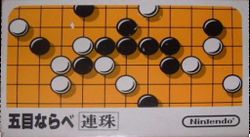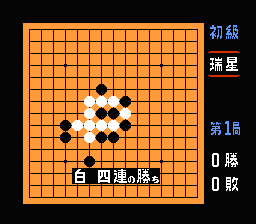
| Gomoku Narabe Renju | |
|---|---|
| Developer(s) | Nintendo |
| Publisher(s) | Nintendo |
| Year released | 1983 |
| System(s) | Famicom, Wii |
| Japanese title | 五目ならべ 連珠 |
|---|---|
| Genre(s) | Board game |
| Players | 1-2 |
| Modes | Single player, Multiplayer |
| Rating(s) |
Gomoku Narabe Renju was the fourth game released for the Famicom by Nintendo. 'GoMoku' is Japanese and means '5 Points' and 'Narabe' translates to 'in-a-row'. It is similar to a game of Tic-Tac-Toe on first sight. It is often known as 'Connect Five', 'Spoil Five', 'Pegity' or 'Go-bang' in the West among many other variations. Do not be confused that the word 'Go' is in the title. The game is merely played with a Go board and pieces, but 'Go' means 'Five' in Japanese as well. This game also follows 'Renju' rules, so often the game is just referred to as 'Renju'. It was later released for the Wii Virtual Console, and it was never published outside of Japan.
Controls
 : Move on the board
: Move on the board : Set a tile
: Set a tile : Surrender (Be careful not to surrender by mistake!)
: Surrender (Be careful not to surrender by mistake!) : Select on the main menu / Pause/Unpause the game during play
: Select on the main menu / Pause/Unpause the game during play : Cycle through the main menu
: Cycle through the main menu
Main Menu
At the main menu you can choose between three difficulty settings: Easy, Medium and Hard. The fourth option is to play against another person, i.e. 2-Player Mode.
Display

During the game, there is a small bar on the right side. The top is the level you are playing on, as chosen on the main menu. Underneath is the name of the opening the CPU has chosen to start out as. The lower numbers indicate the round you are in, the number of wins and the number of losses.
If you are playing 2-Player mode, the difficulty setting is not display and instead of losses it only counts wins for both players (I and II).
How to Play
Unlike Tic-Tac-Toe where there is usually a draw if both players pay attention, there is always a possibility to win in Gomoku Narabe. The original game method was flawed and black had a clear advantage, but with some special rules set it was made equally winnable for both colors.
Each player alternates to place a piece on the board of his or her color. They cannot be moved or removed once put down. The winner is the first player to get an unbroken row of five stones horizontally, vertically, or diagonally in any direction. Note that there are some rules that apply to the black color.
Rules
Since 1936 it has been proven that black can win by perfect play, some rules were introduced to keep the game fair and reduce black's advantage. The game follows the Renju rules:
- Overlines
- Black only wins with five pieces in a row count as a win, rows of six or more are called Overlines and will result in a loss instead. White on the other hand, has no such restrictions and wins with any row of five or more.
- Three-And-Three
- Black may not form two rows or three pieces in a row at the same time. For example:
x** * *
- Placing a piece at 'x' would result in two rows as mentioned above. This rule only applies if there are no white tiles on either end of the black rows.
- Four-And-Four
- Similar to Three-And-Three, but by placing two rows of fours at the same time. The difference to the above rule is that it does not matter if a row is ended by a white piece, it is still against the rules.
Strategy
There are no real expert strategies in this game.
You just have to watch out for where the opponent places their pieces. If you see an attempt to make four-in-a-row then you may be in for a tricky situation. If a person enables four-in-a- row with both sides empty, there is no way of stopping the next move making this five. You cannot really hide your moves, and sneaking in a hidden piece. Not making your attempts to get five-in-a-row too obvious won't do much good either.
Your pieces are better off in the center of the board, rather than on the side as there are more ways to use them. On the side you can only use it from 50 percent and it is easily blocked off. Thus the side rows and columns are usually not covered until later on in the game.
Forcing moves is a good way to keep control of the flow and gain an upper hand. For black this is not so easy to do.
Black needs to play special attention to the moves, so they do not break the rules as seen in the previous section. This means moves need to planned more carefully or you will lose instantly. There is no time limit on moves.
White may use the applied restrictions to force black into making a fatal move or simply not prevent white from winning. Check for patterns to see if you can make shorter rows that end up being near black pieces that would result in three-to-three or four-to-four. White should also leave those spaces empty and first build around to make a five-in-a-row (or setup for it) while black cannot place a piece in that spot.
And finally, practice is required to understand the game's situations, to further develop your own tactics and strategies.